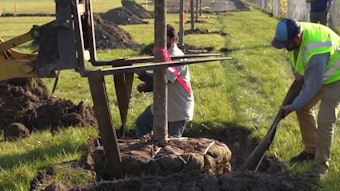
Winter conditions may present challenges to your lawn and landscape. Mechanical damage can appear from snow plowing and weather elements, such as ice, snow, wind and freezing temperatures. Chemical damage can appear from ice-melting agents and cause visible damage. Ray Iacobucci, regional technical manager for TruGreen, has provided tips on dealing with mechanical and chemical damage, and precautions to consider during the winter months.
Mechanical Damage
During times of moderate to heavy snowfall, it is difficult for snowplow drivers to see the boundaries of paved surfaces, making areas adjacent to drives and parking areas at risk for snow plow damage. To help prevent snow plow damage, install brightly colored boundary markers along the edges of paved areas. Lightweight wooden stakes, at least four feet tall with bright reflective tape and brightly covered fiberglass rods, serve as good markers. Avoid heavy metal, fence posts and other large objects, as they can pose a hazard to snowplow operators.
Damage can also occur to shrubs lining the edge of drives, walkways and parking lot islands. Using boundary markers on these areas will also help prevent damage, but if there is long-term damage, it may require shrubs to be removed and planted elsewhere.
When a storm occurs, a coating of snow or ice can cover tree and shrub limbs. When limbs endure heavy ice coating, little can be done to alleviate the loads. To keep twigs and limbs from breaking, do not try to break off the ice. Instead, lightly brush any snow load from the plants, which will reduce the weight on the limbs and decreases the damage. To help support stems of shrubs, such as boxwood and yews, place a burlap enclosure over them. For taller shrubs, lightly strap stems to each other with flexible stem ties, but make sure to remove them in the spring.
Low Temperature and Desiccation Damage
When extremely low temperatures occur, especially for extended periods, plants, shrubs and trees can be partially damaged or perish. The resulting damage is typically noticed in the spring when plants fail to produce new growth. To help prevent damage, maintain a two- to four-inch layer of mulch, which helps roots, which are more susceptible to cold damage, survive and allow new growth in spring.
A rapid plunge in temperature, followed by a mild spell, can cause stems and trunks to crack, especially on thin-barked trees. To help prevent cracking or splitting, wrap the trunk with a light-colored bark wrap.
When plants cannot replace moisture that is lost from leaves, desiccation occurs. A common cause is when there is little or no snow cover and the root zone of the plant, tree or shrub freezes. When coupled with low winter humidity, winter winds and sunlight reflection off snow, leaf tissue desiccation can occur. To prevent desiccation, it is best to maintain two to four inches of mulch, water plants during periods of winter thaw, apply an anti-desiccation film and provide wind breaks.
Chemical Damage
Ice melting agents contain various types of salts that may cause damage to leaf tissue and roots.
Types of agents that are harmful include rock salt and products with a concentration of sodium chloride, calcium and magnesium chloride. These products are considered exothermic, releasing heat in the process of dissolving.
Products with a potassium chloride blend, which is used as a plant nutrient, are easier on your lawns but can still cause harm during use. The safest product to use is calcium magnesium acetate, an alternative to road salt. This product is noncorrosive, biodegradable and safe for plants when used in a non-concentrated form.
To avoid damage from ice melting agents, use the least damaging agents near your lawn and landscape, use agents in advised amounts and avoid piling snow and slush laden with salt materials along lawn edges and shrub beds.



























